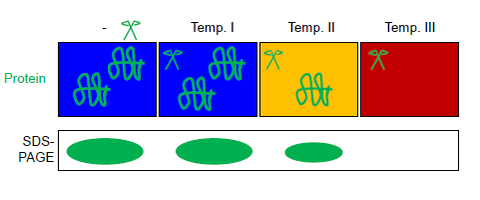Fast parallel proteolysis (FASTpp) is a method to determine the thermostability of proteins by measuring which fraction of protein resists rapid proteolytic digestion.[1]

History and background
editProteolysis is widely used in biochemistry and cell biology to probe protein structure.[2][3] In "limited trypsin proteolysis", low amounts of protease digest both folded and unfolded protein but at largely different rates: unstructured proteins are cut more rapidly, while structured proteins are cut at a slower rate (sometimes by orders of magnitude). Recently, several other assays of protein stability based on proteolysis have been proposed, exploiting other proteases with high specificity for cleaving unfolded proteins. These include Pulse Proteolysis,[4] Proteolytic Scanning Calorimetry [5] and FASTpp.
How it works
editFASTpp measures the quantity of protein that resists digestion under various conditions. To this end, a thermostable protease is used, which cleaves specifically at exposed hydrophobic residues. The FASTpp assay combines the thermal unfolding, specificity of a thermostable protease for the unfolded fraction with the separation power of SDS-PAGE.[6] Due to this combination, FASTpp can detect changes in the fraction folded over a large physico-chemical range of conditions including temperatures up to 85 °C, pH 6–9, presence or absence of the whole proteome. Applications range from biotechnology to study of point mutations and ligand binding assays.
Applications
editFASTpp has been used to probe:[1]
- Lysate effect on protein stability
- Thermal proteome stability [7]
- Coupled folding and binding [8]
- Ligand effects on fraction folded & stability [9]
- Effects of mutations on fraction folded & stability (e.g. point mutation/missense mutations[9][10])
- Kinetic protein stability [11]
Technology
editFirst, a cell lysate is generated by glass beads beating, pressure homogenisation or chemical or physical lysis methods that do not denature the protein(s) of interest. (Optionally for targeted analysis) a protein of interest is purified out of this lysate by affinity methods based on intrinsically disordered tags [12] or other suitable purification strategies, often involving several orthogonal chromatographic steps.
This (total or purified) protein solution is aliquoted into several tubes of a PCR strip. All aliquots are exposed in parallel in a thermal gradient PCR cycler to different maximal temperatures in presence of the thermostable protease thermolysin (see figure). Automated temperature control is achieved in a thermal gradient cycler (commonly used for PCRs). Reaction products can be separated by SDS-PAGE or western blot.[6] The protease thermolysin can be fully inactivated by EDTA. This feature of thermolysin makes FASTpp compatible with subsequent trypsin digestion e.g. for mass spectrometry.[13][14] [7]
References
edit- ^ a b Minde, D. P.; Maurice, M. M.; Rüdiger, S. G. D. (2012). Uversky, Vladimir N (ed.). "Determining Biophysical Protein Stability in Lysates by a Fast Proteolysis Assay, FASTpp". PLOS ONE. 7 (10): e46147. Bibcode:2012PLoSO...746147M. doi:10.1371/journal.pone.0046147. PMC 3463568. PMID 23056252.
- ^ Johnson, D. E.; Xue, B.; Sickmeier, M. D.; Meng, J.; Cortese, M. S.; Oldfield, C. J.; Le Gall, T.; Dunker, A. K.; Uversky, V. N. (2012). "High-throughput characterization of intrinsic disorder in proteins from the Protein Structure Initiative". Journal of Structural Biology. 180 (1): 201–215. doi:10.1016/j.jsb.2012.05.013. PMC 3578346. PMID 22651963.
- ^ Hoelen, H.; Kleizen, B.; Schmidt, A.; Richardson, J.; Charitou, P.; Thomas, P. J.; Braakman, I. (2010). Uversky, Vladimir N (ed.). "The Primary Folding Defect and Rescue of ΔF508 CFTR Emerge during Translation of the Mutant Domain". PLOS ONE. 5 (11): e15458. Bibcode:2010PLoSO...515458H. doi:10.1371/journal.pone.0015458. PMC 2994901. PMID 21152102.
- ^ Park, C.; Marqusee, S. (2005). "Pulse proteolysis: A simple method for quantitative determination of protein stability and ligand binding". Nature Methods. 2 (3): 207–212. doi:10.1038/nmeth740. PMID 15782190. S2CID 21364478.
- ^ Tur-Arlandis, G.; Rodriguez-Larrea, D.; Ibarra-Molero, B.; Sanchez-Ruiz, J. M. (2010). "Proteolytic Scanning Calorimetry: A Novel Methodology that Probes the Fundamental Features of Protein Kinetic Stability". Biophysical Journal. 98 (6): L12 – L14. Bibcode:2010BpJ....98L..12T. doi:10.1016/j.bpj.2009.11.028. PMC 2849053. PMID 20303845.
- ^ a b Laemmli, U. K. (1970). "Cleavage of structural proteins during the assembly of the head of bacteriophage T4". Nature. 227 (5259): 680–685. Bibcode:1970Natur.227..680L. doi:10.1038/227680a0. PMID 5432063. S2CID 3105149.
- ^ a b Leuenberger, P; Ganscha, S; Kahraman, A (2017). "Cell-wide analysis of protein thermal unfolding reveals determinants of thermostability". Science. 355 (6327): eaai7825. doi:10.1126/science.aai7825. PMID 28232526. S2CID 8432125.
- ^ Demarest, S. J.; Martinez-Yamout, M.; Chung, J.; Chen, H.; Xu, W.; Dyson, H. J.; Evans, R. M.; Wright, P. E. (2002). "Mutual synergistic folding in recruitment of CBP/p300 by p160 nuclear receptor coactivators". Nature. 415 (6871): 549–553. doi:10.1038/415549a. PMID 11823864. S2CID 4423920.
- ^ a b Robaszkiewicz, K.; Ostrowska, Z.; Cyranka-Czaja, A.; Moraczewska, J. (2015). "Impaired tropomyosin–troponin interactions reduce activation of the actin thin filament". Biochimica et Biophysica Acta (BBA) - Proteins and Proteomics. 1854 (5): 381–390. doi:10.1016/j.bbapap.2015.01.004. PMID 25603119.
- ^ Minde, D. P.; Anvarian, Z.; Rüdiger, S. G.; Maurice, M. M. (2011). "Messing up disorder: How do missense mutations in the tumor suppressor protein APC lead to cancer?". Molecular Cancer. 10: 101. doi:10.1186/1476-4598-10-101. PMC 3170638. PMID 21859464.
- ^ Tur-Arlandis, G.; Rodriguez-Larrea, D.; Ibarra-Molero, B.; Sanchez-Ruiz, J. M. (2010). "Proteolytic Scanning Calorimetry: A Novel Methodology that Probes the Fundamental Features of Protein Kinetic Stability". Biophysical Journal. 98 (6): L12 – L14. Bibcode:2010BpJ....98L..12T. doi:10.1016/j.bpj.2009.11.028. PMC 2849053. PMID 20303845.
- ^ Minde, DP; Halff, EF; Tans, SJ (2013). "Designing disorder: Tales of the unexpected tails". Intrinsically Disordered Proteins. 1 (1): e26790. doi:10.4161/idp.26790. PMC 5424805. PMID 28516025.
- ^ Chang, Y; Schlebach, JP; Verheul, RA; Park, C (2012). "Simplified proteomics approach to discover protein-ligand interactions". Protein Science. 21 (9): 1280–7. doi:10.1002/pro.2112. PMC 3631357. PMID 22733688.
- ^ Park, C; Marqusee, S (2005). "Pulse proteolysis: A simple method for quantitative determination of protein stability and ligand binding". Nature Methods. 2 (3): 207–12. doi:10.1038/nmeth740. PMID 15782190. S2CID 21364478.